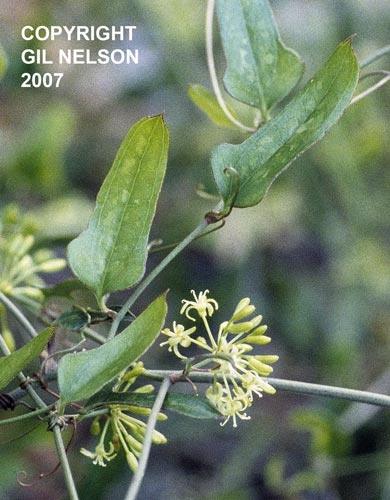Smilax auriculata
| Smilax auriculata | |
|---|---|

| |
| Photo taken by Gil Nelson | |
| Scientific classification | |
| Kingdom: | Plantae |
| Division: | Magnoliophyta – Flowering plants |
| Class: | Liliopsida – Monocotyledons |
| Order: | Liliales |
| Family: | Smilacaceae |
| Genus: | Smilax |
| Species: | S. auriculata |
| Binomial name | |
| Smilax auriculata Walter | |

| |
| Natural range of Smilax auriculata from USDA NRCS Plants Database. | |
Common name: earleaf greenbrier
Contents
Description
A description of Smilax auriculata is provided in The Flora of North America.
Distribution
Ecology
Habitat
It can be found in xeric areas with well-drained, sandy soils (Menges and Kohfeldt 1995; Foster and Schmalzer 2003). Oak-saw palmetto scrub (Foster and Schmalzer 2003). Scrubby flatwoods (which include oaks, dwarf palmettos and ericads)-Olano et al 2006. “Fire is the primary ecological disturbance in this ecosystem…”(Olano et al 2006). “Southern Xeric Longleaf Pine Woodlands” classification according to Peet and Allard 1993, states Provencher et al 2001, where it includes P. palustris, Q. laevis, Q. incana, Sporobolus junceus, and Licania michauxii – where Smilax auriculata is accounted for most of the groundcover density (Rodgers and Provencher 1999) – Provencher et al 2001. Occurred in a mixed stand of slash and longleaf pine; soils were mainly sandy, siliceous, hyperthermic Ultic haplaquod of the Pomona series (Moore et al 2982). It can be found in scrub and sandhill communities (Menges and Kohfeldt 1995; Reinhart et al 2004).
Phenology
“is a woody vine with large specializes storage organs enabling rapid postfire recovery.” – Olano et al 2006.
Seed dispersal
Seed bank and germination
It can reproduce by resprouting, clonal spreading, and seeding (Menges and Kohfeldt 1995).
Fire ecology
It increases in abundance after fire (Menges and Kohfeldt 1995). Its rapid recovery post-fire can be attributed to large specialized storage organs (Olano et al 2006). However, Greenberg found out that S. auriculata decreased to almost nonexistent following a May fire (2003). This suggests that season of burning is important for this species.
Pollination
The following Hymenoptera families and species were observed visiting flowers of Smilax auriculata at Archbold Biological Station (Deyrup 2015):
Apidae: Apis mellifera
Halictidae: Augochlora pura
Megachilidae: Coelioxys dolichos, Megachile mendica, M. xylocopoides
Use by animals
S. auriculata was found in 5.5% of the Gopherus polyphemus scat observed by Carlson and her team (2003). Thus, the gopher tortoise can serve as an agent of seed dispersal. Deyrup (2002) observed these bees, Augochlora pura, Coelioxys dolichos, Megachile mendica, M. xylocopoides, Apis mellifera, Xylocopa micans, X. virginica krombeini, on S. auriculata.
Diseases and parasites
Conservation and Management
Cultivation and restoration
Photo Gallery
References and notes
Carlson, J. E., E. S. Menges, et al. (2003). "Seed dispersal by Gopherus polyphemus at Archbold Biological Station, Florida." Florida Scientist 66: 147-154.
Deyrup, M.A. and N.D. 2015. Database of observations of Hymenoptera visitations to flowers of plants on Archbold Biological Station, Florida, USA.
Deyrup, M. and L. Deyrup (2012). "The diversity of insects visiting flowers of saw palmetto (Arecaceae)." Florida Entomologist 95(3): 711-730.
Greenberg, C. H. (2003). "Vegetation recovery and stand structure following a prescribed stand-replacement burn in sand pine scrub." Natural Areas Journal 23: 141-151.
Menges, E. and N. Kohfeldt (1995). "Life History Strategies of Florida Scrub Plants in Relation to Fire." Bulletin of the Torrey Botanical Club 122(4): 282-297
Menges, E. S. and N. M. Kohfeldt (1992). Life history strategies of scrub plants in relation to fire [abstract]. History and Ecology of the Florida scrub, Lake Placid, FL, Archbold Biological Station.
Moore, W. H., B. F. Swindel, et al. (1982). "Vegetative response to prescribed fire in a north Florida flatwoods forest." Journal of Range Management 35: 386-389.
Olano, J. M., E. S. Menges, et al. (2006). "Carbohydrate storage in five resprouting Florida scrub plants across a fire chronosequence." New Phytologist 170: 99-105.
Provencher, L. M., B. J. Herring, et al. (2001). "Effects of hardwood reduction techniques on longleaf pine sandhill vegetation in northwest Florida." Restoration Ecology 9: 13-27.
Reinhart, K. O. and E. S. Menges (2004). "Effects of re-introducing fire to a central Florida sandhill community." Applied Vegetation Science 7: 141-150.
Schmalzer, P. A., S. R. Turek, et al. (2002). "Reestablishing Florida scrub in a former agricultural site: survival and growth of planted species and changes in community composition." Castanea 67: 146-160.